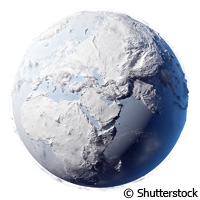Was the Earth ever covered in ice? Scientists re-open the debate!
It has long been believed that some 635 million years ago the Earth was completely covered in ice, but now new research from an international team of scientists has thrown this long-held hypothesis into serious question. Their findings indicate that the atmospheric concentration of CO2 during that period was much lower than previously thought. Writing in the journal Nature, the team, from Brazil, France and the United States, challenge the 'Snowball Earth' hypothesis. They have re-opened the debate about the so-called 'deglaciation mechanism', the process by which glaciated land is uncovered due to the melting of the glacier. Scientists believe the Earth has experienced several extreme glacial events, two of which took place during the Cryogenian period, 710 million to 630 million years ago. In 1992 and 1998, scientists hypothesised that around 635 million years ago, the Earth underwent a major glacial episode that left it entirely smothered in ice. However the question of how this period came to an end remains unanswered. According to the 'Snowball Earth' hypothesis, enough CO2 of volcanic origin had built up in the atmosphere for this greenhouse gas to warm up the surface of the planet and cause the ice to melt. According to this scenario, CO2 concentrations must have fluctuated around 12%, 300 times greater than CO2 concentrations today. However in this new research, the team show that CO2 concentrations were actually much closer to what they are today, which is far from being sufficient to bring about the end of a glacial episode of this magnitude. This throws doubt onto the entire 'Snowball Earth' theory and also suggests that these glacial episodes were perhaps not as intense as has been suggested in previous studies. But just how were the team able to assess atmospheric concentration of CO2 at that time? The team studied Brazilian carbonates deposited 635 million years ago, sediments that cap the glacial deposits left from that time. The study is based on the difference in carbon isotopic composition between carbonates and organic matter in fossilised organisms, which reflects atmospheric concentrations of CO2. The studied cap carbonates come from the south-eastern margin of the Amazonian craton, an ancient granitic continental fragment that spans much of Brazil.For more information, please visit:CNRS:http://www.cnrs.fr/index.php
Countries
France

